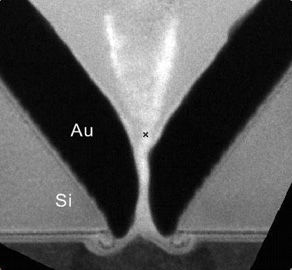Direct optical reading of single-molecule DNA bases in modified nanopores
Unique combination of SERS and nanopore fluidics
IMEC describes a new concept for direct identification of single DNA bases. The technique has the potential to detect, with an unprecedented spatial resolution and without any labeling, the genetic code, as well as epigenetic variations in DNA. The combination of nanopore fluidics and surface enhanced Raman spectroscopy makes it a unique concept and a very promising tool for evolutionary biologists and for research on disease development.
Today, direct, real-time identification of nucleobases in DNA strands in nanopores is limited by the sensitivity and the spatial resolution of established ionic sensing strategies. In addition, established DNA sequencing techniques often use fluorescent labeling which is costly and time-consuming. In its Nature Communications paper, imec demonstrated a promising alternative based on optical spectroscopy, with no need for labeling and with the unique ability to identify nucleobases, individually, and incorporated in a DNA strand. The technique is based on nanofluidics to drive the DNA strand through an engineered plasmonic nanoslit, and surface enhanced Raman spectroscopy to make a ‘fingerprint’ of the adsorbed nucleobases up to the level of molecular bonds. The spectroscopic signal is enhanced both by a gold coating on top of the nanoslit, and the engineered shape of the nanoslit. “The result reported here is an important step towards a solution for fast and direct sequencing up to the epigenetic level,” stated and Chang Chen, senior researcher at imec.
The signal generated by Raman spectroscopy holds a lot of information about the molecules and the molecular bonds. Not only can the DNA code be ‘read’, but also base modifications such as methylation, histone acetylation, and microRNA modification, which carry more detailed information about epigenetic variations. Such variations are important for evolutionary studies as they influence gene expression in cells. Moreover, they have been shown to impact the origin and development of diseases such as cancer.
“We leverage our world-class expertise in chip design and 300 mm Si wafer manufacturing technology and bio-lab facilities to develop tailored solutions for the life sciences industry,” stated Pol Van Dorpe, principal member of technical staff. “The solution we describe here is only one example of the technologies we are working on. Our toolbox includes knowledge on nanopores, spectroscopy, photonics, single-molecule detection and nanofluidics which we use in developing next-generation solutions for our industry partners in genomics and diagnostics.

Sub-10nm Nanoslit
imec
Original publication
Chang Chen, Yi Li, Sarp Kerman, Pieter Neutens, Kherim Willems, Sven Cornelissen, Liesbet Lagae, Tim Stakenborg & Pol Van Dorpe; "High spatial resolution nanoslit SERS for single-molecule nucleobase sensing"; Nature Comm.; 2018
Most read news
Original publication
Chang Chen, Yi Li, Sarp Kerman, Pieter Neutens, Kherim Willems, Sven Cornelissen, Liesbet Lagae, Tim Stakenborg & Pol Van Dorpe; "High spatial resolution nanoslit SERS for single-molecule nucleobase sensing"; Nature Comm.; 2018
Topics
Organizations
Other news from the department science

Get the life science industry in your inbox
From now on, don't miss a thing: Our newsletter for biotechnology, pharma and life sciences brings you up to date every Tuesday and Thursday. The latest industry news, product highlights and innovations - compact and easy to understand in your inbox. Researched by us so you don't have to.
Most read news
More news from our other portals
See the theme worlds for related content
Topic World Spectroscopy
Investigation with spectroscopy gives us unique insights into the composition and structure of materials. From UV-Vis spectroscopy to infrared and Raman spectroscopy to fluorescence and atomic absorption spectroscopy, spectroscopy offers us a wide range of analytical techniques to precisely characterize substances. Immerse yourself in the fascinating world of spectroscopy!

Topic World Spectroscopy
Investigation with spectroscopy gives us unique insights into the composition and structure of materials. From UV-Vis spectroscopy to infrared and Raman spectroscopy to fluorescence and atomic absorption spectroscopy, spectroscopy offers us a wide range of analytical techniques to precisely characterize substances. Immerse yourself in the fascinating world of spectroscopy!
Topic world Diagnostics
Diagnostics is at the heart of modern medicine and forms a crucial interface between research and patient care in the biotech and pharmaceutical industries. It not only enables early detection and monitoring of disease, but also plays a central role in individualized medicine by enabling targeted therapies based on an individual's genetic and molecular signature.

Topic world Diagnostics
Diagnostics is at the heart of modern medicine and forms a crucial interface between research and patient care in the biotech and pharmaceutical industries. It not only enables early detection and monitoring of disease, but also plays a central role in individualized medicine by enabling targeted therapies based on an individual's genetic and molecular signature.

























































